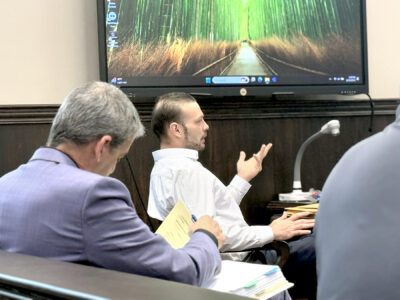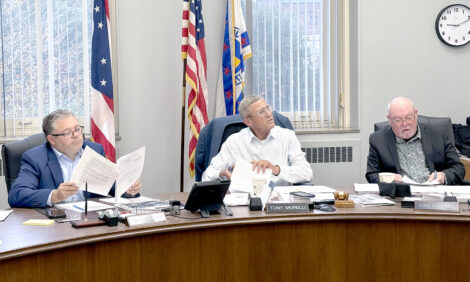Aircraft association shares admiration for aviation

AIRCRAFT ADDICTS — Members of Experimental Aircraft Association Chapter 859, based out of the Geary A. Bates Jefferson County Airpark, met on Jan. 11 to plan their 2024 calendar of events. From left, front, are Secretary MaryAnn Freeze; Vice President Mike Zeiler; member Christen Tulenko; and back, Treasurer Doug Cooke; and President David Tulenko. -- Christopher Dacanay
WINTERSVILLE — For some, aviation is just another form of transportation. For others, it’s a deep-seated passion they want to share.
Sharing that passion with others is part of the mission behind Experimental Aircraft Association Chapter 859. Based out of the Geary A. Bates Jefferson County Airpark, the association is made up of members whose love for aviation unites them. Many are pilots, and a few go so far as to build their own aircraft.
An experimental aircraft is one of various classifications of functional aircraft that a pilot builds himself or herself. Some can be purchased in a pre-designed kit from an airplane supply company, while others might be an antique restoration.
There’s a wide range of designs and capabilities, said David Tulenko, the chapter’s president. One of the planes Tulenko is working on is an Evans VP-1 Volksplane, which cruises around 75 mph, though other experimental aircraft can reach top speeds of up to 300 mph, depending on the engine.
“If you put a motor on a seat, it’s considered experimental,” joked Tulenko, adding that certain planes can legitimately be assembled using components purchased at a home goods store,
Another experimental aircraft is the Sonerai II, which association Vice President Mike Zeiler got around 1985 and rebuilt as a “learning experience.”
The association’s eight current members belong to and pay dues to the international EAA. Based out of Oshkosh, Wis. — home of the popular EAA AirVenture Oshkosh airshow — the EAA is an organization representing the worldwide recreational aviation community.
Though many of Chapter 859’s members are pilots and build experimental aircraft, those aren’t requirements for membership. All one needs is an interest in aviation and a desire to learn.
“You don’t have to be a pilot or a builder to be one of us,” said Treasurer Doug Cooke. “It’s more about the people you meet once you join.”
A great advantage of the EAA chapter for airplane builders is having a forum to connect with other builders, Tulenko said, adding that members often share their expertise as they relate to projects. The scope of projects is vast, and there’s a lot to know, especially as it relates to the plentiful Federal Aviation Administration regulations on experimental aircraft.
Aircraft can be as small and simplistic as an “ultralight,” which, if powered, must weigh less than 254 pounds, carry less than five gallons of fuel and travel no more than 63 mph. Ultralights, however, do not require an aircraft certification to fly, but that doesn’t mean it’s a good idea to fly without any prior instruction.
Other experimental aircraft projects include autogyros, which utilize a free-spinning rotor to generate lift, and antique aircraft, which Tulenko said builders often treat like others might treat an antique car.
Tulenko said planes must be inspected by an airframe and powerplant mechanic, a certified aviation mechanic, every year, and each new plane must be inspected, passed and registered by an FAA-designated airworthiness representative.
By the end of a build project, Tulenko said, builders have the advantage of knowing their planes “inside and out.” However, instruction is still necessary, with larger aircraft classifications requiring certification, instructors for which are available at each different airfield.
The chapter’s meetings are every second Thursday of the month at 7 p.m. in the conference room of the terminal building, 600 Airpark Road, Wintersville. On the night of Jan. 11, the chapter’s cabinet met to plan its 2024 calendar of events, meant to accomplish the chapter’s goal of spreading appreciation for aviation.
“Our goal is to try and get as many individuals involved as possible,” said Tulenko, who received his certificate right out of high school in 1972.
Integral to the chapter is its outreach events, including bringing in historical aircraft for individuals to view, sponsoring tours to other airfields and creating opportunities for others to experience flying first-hand.
The chapter has been successful with its ventures for the EAA Young Eagles program, which seeks to kickstart a love for aviation among youth by providing them with a free introductory flight. Spurred on by the memory of their own first flights, the chapter members desire to give others that exhilarating experience and, hopefully, start kids on their aviation career path.
Previous participants in the Young Eagles program include students from the School of Bright Promise, as well as Boy and Girl Scouts — the Boy Scouts hold the chapter’s record for most flights, on one occasion having more than 100 Scouts who were working on their aviation merit badge. The chapter has even taken nursing home residents up into the sky, Tulenko said, and it is “blessed” to have no previous incidents with flights.
“That’s part of the reward of doing what we do. You reach out and touch everybody,” said Tulenko, noting how some Young Eagles have gone on to have careers as pilots or air traffic controllers, and pilots who provide the flights donate their time, planes and fuel, never asking for anything in return.
Cooke said, “Our main mission is to introduce people to aviation. And it’s not just about being a pilot or building planes, it can be about any aviation career.”
Chapter Secretary MaryAnn Freeze herself isn’t a pilot or builder. She’s active with the EAA simply out of a love for planes, which she would always look up to see when she heard one as a child. Similarly interested is Tulenko’s daughter, Christen Tulenko, who said she loves to hang around the airport.
Just like most other organizations, the chapter — formed in 1988 — is down a bit on membership, and members have noticed a general decline in overall interest in aviation. That’s all the more reason for members to continue their efforts and seek new members.
“We’re always looking for people with new ideas and new energy,” said Cooke, who has been a pilot for about 16 years and received his certificate after an accelerated five months of instruction.
The chapter hopes to host workshops for plane building skills and make use of its leased hangar, a perfect meeting spot when weather is pleasant, Tulenko said. Individuals can look for events and news on the chapter’s Facebook page.
The new year will hopefully bring with it more events and membership for EAA Chapter 859, and any first flights will hopefully spread the love of aviation from one generation to the next because, as Vice President Zeiler observed, “I had the most fun when someone was flying with me.”



